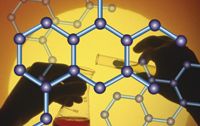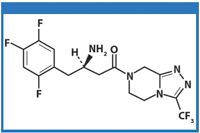Improving Routes in API Manufacturing
Catalytic routes to producing atorvastatin and sitagliptin are recent advancements.
Resolving a problem in the synthesis of an active pharmaceutical ingredient (API) or in scale-up is critical for the drug's commercial success. Several recent examples underscore the versatility of approaches to API manufacturing.

ILLUSTRATION: M. MCEVOY. PHOTOGRAPHY: PHOTOS.COM
Catalytic routes
Pfizer, Inc.'s (New York) "Lipitor" (atorvastatin) is the pharmaceutical industry's top-selling drug, with 2006 sales of $13.6 billion, according to IMS Health (Fairfield, CT). A key intermediate in Lipitor is ethyl (R)-4-cyano-3-hydroxybutyrate, which can be produced through biocatalytic routes.
Dowpharma (Midland, MI) uses a nitrilase developed by Diversa Corporation (San Diego) for the asymmetric hydrolysis of 3-hydroxyglutaronitrile to make ethyl (R)-4-cyano-3-hydroxybutyric acid, which is then converted to ethyl (R)-4-cyano-3-hydroxybutyrate. The route to making ethyl (R)-4-cyano-3-hydroxybutyrate starts with epichlorohydrin, which is subjected to a cyanide reaction. This step is followed by an enzyme desymmetrization (100% theoretical yield) using a nitrilase engineered by Diversa to work at 3-M substrate concentration to give 99% conversion and 99% enantiomeric excess (1, 2).
A key part of the process is the scale-up of the production of the nitralase, which Dowpharma does via its "Pfenex" expression technology to give soluble, active enzyme in titers in excess of 25 g/L fermentation broth. The final step is a simple esterification (1, 2).
Codexis, Inc. (Redwood City, CA) also developed a biocatalytic process for making ethyl (R)-4-cyano-3-hydroxybutyrate. The process involves two enzymes that catalyze the enantioselective reduction of ethyl 4-chloroacetoacetate by glucose to form an enantiopure chlorohydrin. In the second step, a third evolved enzyme catalyzes the biocatalytic cyanation of the chlorohydrin to cyanohydrin under neutral conditions (2).
Merck & Co. Inc.'s (Whitehouse Station, NJ) "Januvia" (sitagliptin) (see Figure 1), a new molecular entity approved by the US Food and Drug Administration (Rockville, MD) in 2006 to treat Type 2 diabetes, is a chiral-β amino acid derivative. In collaboration with Solvias AG (Basel, Switzerland), Merck advanced an approach for the asymmetric catalytic hydrogenation of unprotected enamines to synthesize sitagliptin using a ferrocenyl ligand in a rhodium-based catalyst. This approach improved yield and reduced waste from the reaction (3).

Figure 1: Merck & Co.'s Januvia (sitagliptin), a new molecular entity approved in 2006. (US FOOD AND DRUG ADMINISTRATION)
Production for colesevelam
The production of colesevelam hydrochloride, the API in "WelChol," is an example of a successful scale-up for an API. DSM Pharma Chemicals, a business unit of DSM Pharmaceutical Products (Parsippany, NJ), is evaluating increasing production to meet increased demand for colesevelam, an oral polymeric, lipid-lowering agent. DSM produces colesevelam at its small-molecule manufacturing facility in Linz, Austria.

DSM's manufacturing facility in Linz, Austria. (DSM)
WelChol is marketed by Genzyme Corporation's (Cambridge, MA) US marketing partner for the product, Daiichi Sankyo, Inc. (Parsippany, NJ).
WelChol is indicated for lowering low-density lipoprotein (LDL) cholesterol and was approved by FDA in May 2000. In December 2006, Daiichi Sanyko submitted a supplemental new drug application to the FDA for WelChol to improve glycemic control in patients with Type 2 diabetes mellitus. If approved, WelChol will be the first LDL cholesterol-lowering medication also indicated for improving glycemic control. The new indication for WelChol for treating Type 2 diabetes would potentially increase the volume requirements for colesevelam.
To meet current and projected demand, DSM is evaluating a potential new investment at its Linz facility, which would include the addition of new manufacturing equipment to increase the efficiency in the gel-cutting procedure and the reaction part of the colesevelam production unit.
In December 2006, DSM produced its millionth kilogram of colesevelam at the Linz facility. DSM optimized the manufacturing process for colesevelam and supplied the initial 25 kg for conducting the first human clinical trials to the innovator of the product, Geltex Pharmaceuticals, Inc., which was acquired by Genzyme in 2000. DSM has manufactured the API on a commercial scale since the drug's US marketing approval in 2000 and European approval in 2004.
In optimizing the manufacturing process for colesevelam, DSM had to overcome certain key challenges. Colesevelam is poly (allylamine hydrochloride), cross-linked with epichlorohydrin and alkylated with (6-bromohexyl) trimethylammonium bromide and 1-bromodecane.The main steps of the API synthesis are the cross-linking of poly (allylamine hydrochloride) and the alkylation of the cross-linked polymer.
Geltex first approached DSM with the project because it had difficulty producing the product on an industrial scale. Although the synthesis of the compound was not problematic, the material is a polymer hydrogel, and DSM had to design specialized equipment to cut the material. DSM engineer George Haubel worked with a team that designed the gel cutter and the specific reactors for polymer-suspension reactions.
DSM optimized the manufacturing process for colesevelam, which is carried out by cross-linkage, comminution, alkylation, washing with several washing steps between the individual stages, and drying in a fluid-bed dryer (4). Following polymerization, the cured crude gel is cut in a defined shape, washed with methanol batchwise in a static or stirred bed, followed by alkylation in methanol. The akylated gel is washed in methanol and sodium chloride in a static or stirred bed followed by washes of sodium chloride and final water washes with deionized water (4). Because of the adhesive quality of the gel, the material is dried in a fluid-bed dryer because it adheres to the surface of a cone dryer.
The particle size of the API is important for the clinical efficacy of the drug. Colesevelam is a non-systemic drug that is not absorbed into the bloodstream and does not pass through the liver and kidneys. It travels through the body to the intestines, where it binds to bile acids, which are then carried out of the body by the normal digestive process. Bile acids are made from cholesterol. The body needs to use LDL to make more bile acids. This process reduces the amount of bad cholesterol in the blood.
If the particle size of the API were too small, it would be absorbed by the body, and if too large, it would be retained in the system. Micronization of the API is performed by Powdersize, Inc. (Quakertown, PA).
Aptamer technology
An emerging area in API development is aptamers. Aptamers are single-stranded nucleic acids that form well-defined three-dimensional shapes, which allows them to bind to target molecules in a manner that is conceptually similar to antibodies, according to Archemix (Cambridge, MA), a company specializing in aptamer development. Unlike monoclonal antibodies, aptamers are chemically synthesized, rather than biologically expressed.
Archemix recently signed aptamer drug development pacts with Merck KGaA (Darmstadt, Germany), Takeda Pharmaceutical Company (Osaka, Japan), and Pfizer.
"Macugen" (pegaptanib sodium), which was approved by FDA in 2004, is an example of a commercial aptamer. The drug was developed by Eyetech Pharmaceuticals, which was acquired by OSI Pharmaceuticals (Melville, NY) in 2005. Pegaptanib is a covalent conjugate of a 28-mer oligonucleotide that terminates in a pentylamino linker, to which two 20-kilodalton monomethoxy polyethylene glycol units are covalently attached via the two amino groups on a lysine residue (5).
References
1. K. Holt-Tiffin et al., "Nitrilase-Catalyzed Desymmetrization of 3-Hydroxyglutaronitrile: Preparation of a Statin Side-Chain Intermediate," Org. Process Res. Dev. 10 (3), 661–665 (2006).
2. P. Van Arnum, "Achieving Enantioselectivity in Synthesizing APIs and Intermediates," Pharm. Technol. 30 Technology Outlook: APIs, Intermediates, and Formulation suppl. s20–s25 (2006).
3. P. Van Arnum, "Optimizing Strategies for API Synthesis and Formulation Development," Pharm. Technol. 30 (11), 44–48 (2006).
4. M. Stanek et al., "Preparation of Alkylated N- or Amino, Ammonium or Spirobicyclic Ammonium Group-containing, Cross-linked Polymers," US Patent 7105631, Sept. 12, 2006.
5. Drugs@FDA, www.fda.gov/cder/foi/label/2006/021756s006,s007lbl.pdf (accessed June 4, 2007).

Drug Solutions Podcast: A Closer Look at mRNA in Oncology and Vaccines
April 30th 2024In this episode fo the Drug Solutions Podcast, etherna’s vice-president of Technology and Innovation, Stefaan De Koker, discusses the merits and challenges of using mRNA as the foundation for therapeutics in oncology as well as for vaccines.
Drug Solutions Podcast: Applying Appropriate Analytics to Drug Development
March 26th 2024In this episode of the Drug Solutions Podcast, Jan Bekker, Vice President of Business Development, Commercial and Technical Operations at BioCina, discusses the latest analytical tools and their applications in the drug development market.